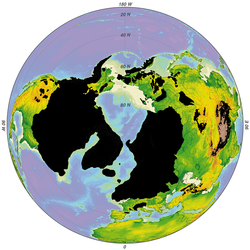
Back Kwartêre Ystydperk Afrikaans غمر جليدي الرباعي Arabic Dördüncü dövr buzlaşmaları Azerbaijani Glaciació del Quaternari Catalan Rhewlifiant Cwaternaidd Welsh Glaciación cuaternaria Spanish یخبندان کواترنری Persian Jääkausiaika Finnish Glaciations quaternaires French Kwartêre Iistiid Frisian

The Quaternary glaciation, also known as the Pleistocene glaciation, is an alternating series of glacial and interglacial periods during the Quaternary period that began 2.58 Ma (million years ago) and is ongoing.[1][2][3] Although geologists describe this entire period up to the present as an "ice age", in popular culture this term usually refers to the most recent glacial period, or to the Pleistocene epoch in general.[4] Since Earth still has polar ice sheets, geologists consider the Quaternary glaciation to be ongoing, though currently in an interglacial period.
During the Quaternary glaciation, ice sheets appeared, expanding during glacial periods and contracting during interglacial periods. Since the end of the last glacial period, only the Antarctic and Greenland ice sheets have survived, while other sheets formed during glacial periods, such as the Laurentide Ice Sheet, have completely melted.
The major effects of the Quaternary glaciation have been the continental erosion of land and the deposition of material; the modification of river systems; the formation of millions of lakes, including the development of pluvial lakes far from the ice margins; changes in sea level; the isostatic adjustment of the Earth's crust; flooding; and abnormal winds. The ice sheets, by raising the albedo (the ratio of solar radiant energy reflected from Earth back into space), generated significant feedback to further cool the climate. These effects have shaped land and ocean environments and biological communities.
Long before the Quaternary glaciation, land-based ice appeared and then disappeared during at least four other ice ages. The Quaternary glaciation can be considered a part of a Late Cenozoic Ice Age that began 33.9 Ma and is ongoing.
- ^ Lorens, L.; Hilgen, F.; Shackelton, N.J.; Laskar, J.; Wilson, D. (2004). "Part III Geological Periods: 21 The Neogene Period". In Gradstein, Felix M.; Ogg, James G.; Smith, Alan G. (eds.). A Geologic Time Scale 2004. Cambridge University Press. p. 412. ISBN 978-0-521-78673-7.
- ^ Ehlers, Jürgen; Gibbard, Philip (2011). "Quaternary Glaciation". Encyclopedia of Snow, Ice and Glaciers. Encyclopedia of Earth Sciences Series. pp. 873–882. doi:10.1007/978-90-481-2642-2_423. ISBN 978-90-481-2641-5.
- ^ Berger, A.; Loutre, M.F. (2000). "CO2 And Astronomical Forcing of the Late Quaternary". Proceedings of the 1st Solar and Space Weather Euroconference, 25-29 September 2000. Vol. 463. ESA Publications Division. p. 155. Bibcode:2000ESASP.463..155B. ISBN 9290926937.
- ^ "Glossary of Technical Terms Related to the Ice Age Floods". Ice Age Floods Institute. Archived from the original on 18 February 2019. Retrieved 17 February 2019.
© MMXXIII Rich X Search. We shall prevail. All rights reserved. Rich X Search